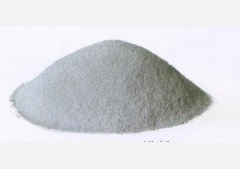Aluminium Powder
| Infobox on Aluminium Powder | |
|---|---|
| Example of Aluminium Powder |  |
| Facts | |
| Origin | - |
| Stowage factor (in m3/t) | - |
| Humidity / moisture | - |
| Ventilation | - |
| Risk factors |
|
Aluminium Powder
Description
Aluminum powder is a light, silvery-white to gray, odourless powder. It is a REACTIVE FLAMMABLE MATERIAL. Moist aluminum powder may ignite in air, with the formation of flammable hydrogen gas. It is also a COMBUSTIBLE DUST. When aluminum powder comes in contact with water, strong acids, strong bases or alcohols, it releases flammable hydrogen gas. It can react violently or explosively with many inorganic and organic chemicals. Aluminum powder is essentially non- toxic following short-term exposure.
Aluminum is the third most abundant element in the earth's crust. Because of its strong affinity for oxygen, aluminum never occurs as a metal in nature and is found only in the form of its compounds, for example aluminum oxide.
Aluminum is normally coated with a layer of aluminum oxide unless the particles are freshly formed. There are two main types of aluminum powder: the "flake" type which is made by stamping the cold metal and the "granulated" type which is made from molten aluminum. Pyro powder is an especially fine type of "flake" powder and is composed of very small particles (less than 1 micrometre (µm) diameter). This chemical profile record contains information for aluminum powders, supplemented with general information for aluminum and its compounds.
The physical properties of aluminum vary significantly according to purity and alloying. The values given in this chemical profile record are for aluminum of a minimum of 99.99% purity.
Some aluminum powders are treated with materials such as stearin to minimize surface oxidation. In addition, some aluminum powders are coated with polystyrene to reduce or eliminate the fire hazard.
Aluminum powder (uncoated) is also known as aluminum powder, aluminum, aluminum flake, aluminum metal, metana.
Application
Aluminum powders are used in paints, pigments, protective coatings, printing inks, rocket fuel, explosives, abrasives and ceramics; production of inorganic and organic aluminum chemicals; and as catalysts. Pyro powder is mixed with carbon and used in the manufacture of fireworks. The coarse powder is used in aluminothermics (thermite reaction).
Shipment / Storage
Combustible, with many of its reactions liable to cause fire and explosion. Uncoated aluminum powder may emit flammable gas when wet.
Aluminium powder is shipped in the form of ingots, mostly bundled by strapping iron. It must be well covered with plastic foils to prevent contamination from other cargo. Scratching and notching on aluminum should be avoided. Also shipped in the form of powder or dust.
Risk factors
PHYSICAL DANGERS:
Dust explosion possible if in powder or granular form, mixed with air.
CHEMICAL DANGERS:
Reacts with water and alcohols, and violently with oxidants, strong acids, strong bases, and chlorinated hydrocarbons causing fire and explosion hazard.
Reference is made to the relevant IMO publications of hazardous cargo.











